Papers by Mohamed Ali Triki

Process Biochemistry, 2012
A new fungal strain that was isolated from old sweet soy sauce was identified, based on subsequen... more A new fungal strain that was isolated from old sweet soy sauce was identified, based on subsequent microscopic studies and analyses of rRNA18S gene sequence, intergenic region rRNA 18S-23S, and aflatoxins production tests, as an Aspergillus oryzae strain. The latter was noted to produce two extracellular α-amylases, namely AmyA and AmyB. The monitoring of alpha-amylase production in the presence and absence of various protease inhibitors indicated that AmyB could be formed from the proteolysis of AmyA. The enzymes were purified to homogeneity through fractional acetone precipitation, size exclusion, and anion exchange chromatography. The molecular masses estimated for AmyA and AmyB by SDS-PAGE were 50 and 42kDa, respectively. The NH2-terminal of the purified proteins showed the same amino acid sequences. Further biochemical characterization assays revealed that both enzymes attained maximal activity at pH 5.6 and 50°C. They were activated and stabilized by Ca2+ and were noted to produce maltose and maltotriose as major starch hydrolysis end products. Overall, the findings of the present study indicate that both AmyA and AmyB exhibit a number of promising properties that make them potential strong candidates for application as additives in the bread making industry.

Bioprocess and Biosystems Engineering, Aug 18, 2015
This study was carried out to evaluate the in vitro and in vivo antifungal efficiency of Aspergil... more This study was carried out to evaluate the in vitro and in vivo antifungal efficiency of Aspergillus tubingensis CTM 507 glucose oxidase (GOD) against plant pathogenic fungi. GOD displayed a wide inhibitory spectrum toward different fungi at a concentration of 20 AU. The GOD had a strong inhibitor effect on mycelia growth and spore germination of Pythium ultimum. Interestingly, the GOD exhibited a potent in vivo antifungal effect against P. ultimum responsible for potato plants disease. The antifungal GOD was purified 13-fold with 27 % yield and a specific activity of 3435 U/mg. The relative molecular mass of the GOD was 180 kDa by sodium dodecyl sulfate polyacrylamide gel electrophoresis (SDS-PAGE). The GOD activity was optimum at pH 4.5 and 60 °C. It was found to be stable over a large pH range (3-9). It also displayed a marked thermostability with a 50-min half-life at 65 °C. The 10 residues of the N-terminal sequence of the purified GOD (S-K-G-S-A-V-T-T-P-D) showed no homology to the other reported GOD, identifying a novel GOD. FTIR spectroscopic analysis revealed the presence of C-O and C=O groups corresponding to a D-glucono-lactone. The findings indicated that GOD is the first A. tubingensis-produced fungicide ever reported to exhibit such promising biological properties. It could become a natural alternative to synthetic fungicides to control certain important plant microbial diseases.
Erwerbs-obstbau, Jan 10, 2022
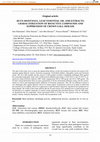
The aims of this study were to assess the antimicrobial efficacy of the leaf essential oil and th... more The aims of this study were to assess the antimicrobial efficacy of the leaf essential oil and the leaf extracts of R. montana against Botrytis cinerea, Fusarium oxysporum, Verticillium dahliae, Aspergillus oryzae and Fusarium solani. The oil (1.000 µg/disk) and the extracts (1.500 µg/disk) revealed a remarkable antifungal effect against the tested plant pathogenic fungi with a radial growth inhibition percentage of 40.0-80.0 % and 5.0-58.0 %, respectively along with their respective MIC values ranging from 100 to 1100 µg/mL and 250 to 3000 µg/mL. The oil had a strong detrimental effect on spore germination of all the tested plant pathogens along with the concentration as well as time-dependent kinetic inhibition of Fusarium oxysporum. Also, the oil exhibited a potent in vivo antifungal effect against Botrytis cinerea on tomato plants. Experiments carried out in plant revealed that the essential oil was slightly effective in suppression of gall formation induced by Agrobacterium tumefaciens on bitter almond. The results of this study indicate that the oil and extracts of R. montana leaves could become natural alternatives to synthetic fungicides to control certain important plant microbial diseases. The GC-MS analysis determined that 28 compounds, which represented 89.03 % of total oil, were present in the oil containing mainly 1-butene, methylcyclopropane, 2-butene and caryophyllene oxide.
Journal of Plant Pathology, Dec 1, 2014
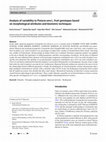
Acta Physiologiae Plantarum, Apr 7, 2020
In this study, numerous properties of pistachio tree (Pistacia vera L.) varieties such as WAHIDI,... more In this study, numerous properties of pistachio tree (Pistacia vera L.) varieties such as WAHIDI, UZUN, RED ALEPPO, OUHADI, AYIMI, KIRMIZI, MOMTEZ, ACHOURY, KERMAN, EL-GUETAR, MATEUR, and NOURI were determined. Physical and mechanical properties of pistachio fruit [(length/width) fruit ratio, fruit form, color of pedicel scar, form of pedicel scar, relief of pedicel scar, percentage of empty fruits, number of knotted flowers/fruit cluster, fruit drop rate, number of fruits/cluster, and percentage of mature fruits] were evaluated. Principal component analysis was applied in the aim to identify the importance of studied parameters and their corresponding correlations. On the basis of obtained results, the most influential fruit character of first principal component (contribution rate = 35%) was relief of pedicel scar, and the most dominant fruit attribute of second principal component (contribution rate = 22%) was form of pedicel scar. Circle of correlation confirmed first that fruit maturity is associated with pistachio size development. Second, to have a high fruit yield, the relief of pedicel scar must be low. Furthermore, Bayesian Networks method was showed in the aim to reveal the relationships between different parameters. Finally, the dendrogram of selected pistachio varieties demonstrates that a high similitude existed between varieties with a similarity value of 0.64. In fact, the dendrogram of pistachio fruit revealed that all studied accessions were divided into three main clusters. Hierarchical clustering revealed that a strong connection existed between physiological and yield traits. These results illustrate a possible use of desired features at least in various infra-specific investigations in P. vera L. to highlight hidden relationships between varieties.

Journal of Plant Pathology, Nov 1, 2011
Bacillus subtilis strain IH7 was isolated from the rhizosphere of Tunisian healthy plants and sel... more Bacillus subtilis strain IH7 was isolated from the rhizosphere of Tunisian healthy plants and selected for its antimicrobial activities against bacteria and fungi. This strain produced a novel antimicrobial peptide (bacteriocin) called Bac IH7. The pure bacteriocin was obtained after precipitation by ammonium sulphate, chromatography on Sephadex G-25 and C18 reverse-phase HPLC. The SDS-PAGE analysis of purified Bac IH7 revealed a single band with an estimated molecular mass of approximately 14 kDa. Bac IH7 was sensitive to various proteases, thus proving to have protein nature and displayed a wide inhibitory spectrum towards Grampositive and Gram-negative bacteria and fungal pathogens. Purified Bac IH7 exhibited a bactericidal mode of action against Agrobacterium tumefaciens C58 and a fungistatic mode of action against Candida tropicalis R2 CIP203. Interestingly, based on conventional agronomic parameters for seed vigour, the application of Bac IH7 (800 AU) showed it to be a potent exogenous enhancer of growth that enhanced the vigour of tomato and muskmelon seedlings. Compared to the control, the germination percentage, shoot weight, shoot height, and root length were all significantly enhanced in the Bac IH7-treated plant seeds. Bac IH7 also exhibited effective disinfectant properties against seedborne diseases. In treated seeds, Bac IH7 had significant effects on the control of damping-off disease groups at the pre-germination stage, of root rot caused by Alternaria solani, as well as of wilt diseases and other bacterial seed-borne pathogens.
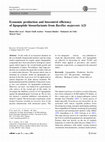
Biodegradation, Dec 6, 2018
In the wake of an increased attention on the eco-friendly biopesticidal products and the rising m... more In the wake of an increased attention on the eco-friendly biopesticidal products and the rising market requirements for organic agents, lipopeptides compounds have been described as biological control agents which improve the overall health growth and development of plants. Nevertheless, their high production cost constitue the major flaw in their wide use to control plant diseases. The present article aims to formulate an economic media for lipopeptides production by Bacillus mojavensis A21 for application as natural fungicides for plant disease treatment. We herein demonstrated the suitability of the potato waste, as low cost substrate, for lipopeptides production. Moreover, sea water was found to be a good mineral salts sources. In the second part of this study, we investigate the inhibitory activity of A21 lipopeptides against the phtopathogenic Fusarium sp. The in vitro test showed a minimal inhibitory concentration of about 0.3 mg/ml. The microscopic examination, of the treated Fusarium revealed an excessive lysis of the mycelia ultrastructure with destructed spores. The in vivo antagonist activity was confirmed towards the infected potato tubers. A21 lipopeptides are effective in decreasing by about 78.26% and 60.68% when applied as preventive and curative treatments, respectively, as compared to the untreated tubers.

Physiological and Molecular Plant Pathology, 2017
Abstract Verticillium wilt is one of the most severe diseases of olive. In this study, differenti... more Abstract Verticillium wilt is one of the most severe diseases of olive. In this study, differential physiological and biochemical responses of two olive cultivars differing by their susceptibility to Verticillium dahliae were investigated using gene expression analyses and monitoring of some physiological and biochemical parameters. Results revealed that early up-regulation of SOD gene, together with a reduced scavenging system activity, resulted in higher H 2 O 2 burst in the resistant cultivar as compared to the susceptible one. In addition, early and simultaneous up-regulation of chitinase and β-1,3-glucanase genes is correlated with reduced susceptibility and wilt symptoms in the resistant cultivar Sayali. The expression level of genes coding for PR10 protein, PLD and WRKY transcription factor was higher in the resistant cultivar, which indicates that induction of the SA pathway is essential for conferring resistance against V . dahliae and reduction of wilt symptoms. Furthermore, comparison of the SA-related genes expression patterns with those followed by the H 2 O 2 burst, chitinase and β-1,3-glucanase genes, revealed that high SA level and H 2 O 2 production, together with enhanced PR proteins activity are a key factor for resistance. As JA-related genes, a strong co-up-regulation of jasmonate ZIM domain and bHLH-binding factor responsive to JA was recorded in both cultivars, except that the extent of this induction was higher in the resistant cultivar. Similarly, the ERF related gene was differentially up-regulated in the two cultivars, which suggests that ET may play a role in the enhancement of olive resistance to V . dahliae . Overall, our findings provide important clues for designing strategies to restrict the effects of this disease.

Springer eBooks, Oct 15, 2019
Precision agricultural skill has constructed and will still construct the road we are moving into... more Precision agricultural skill has constructed and will still construct the road we are moving into this novel theory of precision agriculture. By increasing the inspection and appliance of inputs on the land, farmers are changing from a usual, standardized treatment of every agricultural land to a perfect treatment for as little as possible districts. Remote sensing processes offer a basis for which vegetal stress and growth reaction can be estimated. Remote sensing research based on terrestrial and spatial domains has demonstrated that numerous kinds of plant illness, through pre-visual infection signs for pathogens, hostile species and also plant health indicators, can be identified through aerial hyperspectral imaging. Inspecting foliage using remote sensing data necessitates understanding of the organization and role of foliage and its reflectance characteristics. Sensors have been ameliorated to calculate the reflectance of incident bright at numerous wavebands and have been associated to plant evolution and plant cover. Remote sensing technology has the major advantage to obtaining data about a given entity or region without having physical exchange and frequently employs surface-based instruments or spatial pictures. Remote sensing would be considered as an economic and relevant instrument for land-scale pest controlling and study.

Pest Management Science, Jul 7, 2016
BACKGROUNDThis study aims to characterise the antibacterial activity of a novel Bacillus methylot... more BACKGROUNDThis study aims to characterise the antibacterial activity of a novel Bacillus methylotrophicus strain named 39b against tumourigenic Agrobacterium tumefaciens C58 and B6 strains. It also aims to identify the compound that is responsible for its activity and to evaluate its efficiency to control crown gall disease in tomato plants.RESULTSB. methylotrophicus strain 39b was found to stop the growth of phytopathogenic A. tumefaciens strains in in vitro experiments. Lipopeptides – surfactins, iturins and fengycins – were detected under various isoforms by mass spectrometry analysis of the methanolic extract. The active principle acting against Agrobacterium strains was isolated from TLC plates and identified by mass spectrometry as surfactin. The strain was effective in reducing the weight and the number of galls induced by A. tumefaciens strains on tomato plants. Total inhibition of gall formation was observed using the antibacterial compounds.CONCLUSIONB. methylotrophicus strain 39b exhibited antibacterial activity against phytopathogenic A. tumefaciens C58 and B6 both in vitro and in vivo. Lipopeptides are the main compounds that confer the biocontrol ability. This strain has the potential to be developed as a biological control agent for crown gall disease. © 2016 Society of Chemical Industry
Potato Research, Sep 1, 2001
Summary TwoPythium spp. were isolated from diseased tubers exhibiting rots at harvest, in summer... more Summary TwoPythium spp. were isolated from diseased tubers exhibiting rots at harvest, in summer stores and also in refrigerated storage. Symptoms shared features described for both pink rot caused byPhytophthora erythroseptica and leak caused byPythium spp. The causal agents were identified asPythium aphanidermatum andP. ultimum by morphological and physiological observations and by fingerprinting using oomycete specific primers to amplify the internal

Journal of Applied Microbiology, Jun 12, 2013
To investigate the distribution of chitinase IO8 in Bacillus cereus strains, the enhancing effect... more To investigate the distribution of chitinase IO8 in Bacillus cereus strains, the enhancing effects of the chitinase-producing B. cereus strains on biocontrol potential by dual culture assay and in vivo assay against Botrytis cinerea and also the enhancing effects of the chiIO8 on disinfectant properties against seed-borne diseases. Moreover, the application of chiIO8 treatment was also observed to improve the germinative energy. The purification steps included ammonium sulfate precipitation, with columns of DEAE-Sepharose anion-exchange chromatography and Sephacryl S-400 high-resolution gel chromatography. The method gave a 5.8-fold increase in the specific activity and had a yield of 17%. The molecular weight of the partially purified chitinase chiIO8 was found to be around 30 kDa by sodium dodecyl sulfate-polyacrylamide gel electrophoresis (SDS-PAGE). The optimal pH and optimal temperature of the partially purified chitinase were pH 6.5 and 65°C, respectively. The thermostable chitinase still retained the activity after incubation for 100 min at 65°C, and it was increased about 1.25 times than that of the control (before heating) when the enzyme solution heated at 65°C for 60 min. The partially purified chitinase chiIO8 displays a wide inhibitory spectrum towards all phytopathogenic fungi tested. chiIO8 also exhibited effective disinfectant properties against seed-borne diseases. The present investigation emphasizes the potential of chitinase-producing micro-organism as promising biocontrol agents of fungal plant pathogens with chitinous cell wall. The novel chitinase chiIO8 proved an efficient, environmentally safe and user-friendly solution. This is the first investigation devoted exclusively to analyse the distribution of chitinase in B. cereus. It infers that the chitinase produced by B. cereus might play a role in the activity of the biopesticide.
Biological Control, Dec 1, 2019
This is a PDF file of an article that has undergone enhancements after acceptance, such as the ad... more This is a PDF file of an article that has undergone enhancements after acceptance, such as the addition of a cover page and metadata, and formatting for readability, but it is not yet the definitive version of record. This version will undergo additional copyediting, typesetting and review before it is published in its final form, but we are providing this version to give early visibility of the article. Please note that, during the production process, errors may be discovered which could affect the content, and all legal disclaimers that apply to the journal pertain.
Advances in science, technology & innovation, 2018
The dieback and wilting symptoms induced by complex soilborne fungi has caused considerable econo... more The dieback and wilting symptoms induced by complex soilborne fungi has caused considerable economic losses in olive orchards in Tunisia.
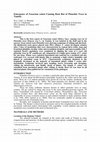
Acta horticulturae, Nov 1, 2011
This is the first report of Fusarium solani (Mart.) Sacc. causing root rot of Pistachio trees Pis... more This is the first report of Fusarium solani (Mart.) Sacc. causing root rot of Pistachio trees Pistacia vera L., in Tunisia. It was isolated in the field and in the nursery from rotted roots Pistachio trees showing symptoms of wilting and die-back. On disinfected roots pieces placed onto PDA culture, F. solani developed colonies after 3 days of incubation that were characterized by typical dirty-white, long and branched phialides, hyaline white microconidium droplets, and macroconidia with 3 septated. Koch's postulates were completed by dipping the roots of 2 years old pistachio trees in 10 6 conidia per mL suspension of a single spore isolate of F. solani for one hour. Plants were repotted (inoculated and controls) in a sterilized soil mix (soil/sand 2:1), covered with plastic film to maintain a high relative humidity and placed in controlled room at 25°C. Characteristic symptoms identical to the originally developed on the majority of inoculated plants within 3 weeks after inoculation. Symptoms involved apex bending, leaves browning and drooping, wilting tip downwards, and finally, death of plants. The fungus F. solani was reisolated from inoculated plants after wilting or death. Root rot was clear in all infected plants when pulled-out for reisolation of the pathogen.
Revue des régions arides, 2008
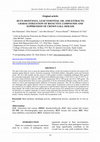
The aims of this study were to assess the antimicrobial efficacy of the leaf essential oil and th... more The aims of this study were to assess the antimicrobial efficacy of the leaf essential oil and the leaf extracts of R. montana against Botrytis cinerea, Fusarium oxysporum, Verticillium dahliae, Aspergillus oryzae and Fusarium solani. The oil (1.000 µg/disk) and the extracts (1.500 µg/disk) revealed a remarkable antifungal effect against the tested plant pathogenic fungi with a radial growth inhibition percentage of 40.0-80.0 % and 5.0-58.0 %, respectively along with their respective MIC values ranging from 100 to 1100 µg/mL and 250 to 3000 µg/mL. The oil had a strong detrimental effect on spore germination of all the tested plant pathogens along with the concentration as well as time-dependent kinetic inhibition of Fusarium oxysporum. Also, the oil exhibited a potent in vivo antifungal effect against Botrytis cinerea on tomato plants. Experiments carried out in plant revealed that the essential oil was slightly effective in suppression of gall formation induced by Agrobacterium tumefaciens on bitter almond. The results of this study indicate that the oil and extracts of R. montana leaves could become natural alternatives to synthetic fungicides to control certain important plant microbial diseases. The GC-MS analysis determined that 28 compounds, which represented 89.03 % of total oil, were present in the oil containing mainly 1-butene, methylcyclopropane, 2-butene and caryophyllene oxide.
Phytopathologia Mediterranea, Feb 4, 2008
Olive trees (Olea europaea) cv. Meski having leaves with yellow spots on the upper surface and gr... more Olive trees (Olea europaea) cv. Meski having leaves with yellow spots on the upper surface and grey blotches on the lower surface were found in three orchards located in the regions of Takelsa, Testour and Enfi dha, central and northern Tunisia. The shoots of the olive trees had also become defoliated indicating a severe attack of a pathogen. Pseudocercospora cladosporioides was isolated from symptomatic leaves and Koch's postulates were fulfi lled. This is the fi rst Tunisian report of P. cladosporioides causing Cercospora leaf spot of olive trees.











Uploads
Papers by Mohamed Ali Triki